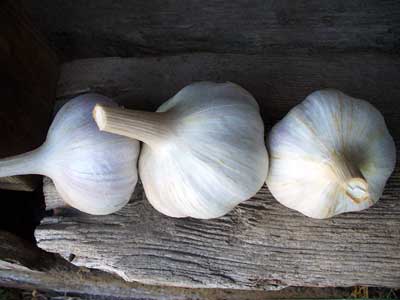Garlic Anti-Inflammatory Sulfur Compounds May Treat Arthritis and Metabolic Disorders
Sulfur compounds and other compounds from garlic are anti-inflammatory. Thiacremonone, a garlic sulfur compound, has anti-inflammatory and anti-arthritic properties. This may mean that it is a good treatment for inflammatory and arthritic diseases (Ban et al. 2009). Other sulfur compounds in garlic, including alliin and ajoene, reduce inflammation by a similar mechanism (Lee et al. 2012, Quintero-Fabián et al. 2013).
Picture: Delicious Phillips garlic bulbs rest on weathered wood boards.
Disorders linked to excess inflammation include metabolic disorders such as type 2 diabetes, high blood pressure, cardiovascular disease, obesity and abnormal cholesterol ratios. There is some research to suggest that garlic can protect against these disorders (Arreola et al. 2015).
How Does Garlic Reduce Inflammation?
Take home message: What does this mean in English? Sulfur compounds in garlic inhibit NF-κB which helps prevent inflammation and arthritis (Ban et al. 2009). In addition, alliin inhibits inflammatory cytokines and calms down inflammation in fat cells (Quintero-Fabián et al. 2013). For more on garlic and arthritis see how garlic may prevent hip osteoarthritis.
Mechanism #1: Thiacremonone inhibits nuclear factor (NF)-κB activation by interacting with the sulfhydryl group of NF-κB molecules (Ban et al. 2009). NF-κB are a family of transcription factors. Transcription factors hang out in the cell cytoplasm until they are activated. Once activated they enter the cell nucleus and modify genes. NF-κB activates (promotes transcription) of inflammatory response genes and are part of a signal pathway promoting inflammation. NF-κB regulates inflammatory and immune response properties by increasing the expression of specific cellular genes. It also turns on production of inflammatory cytokines, such as IL-1, IL-2, IL-6, IL-8 and TNF-α, as well as genes encoding cyclooxygenase-2 (COX-2) and inducible NO synthase (iNOS) (Haefner 2002).
This means that activation of NF-κB increases inflammation. Inhibiting NF-κB can help treat or halt autoimmune, inflammatory, and osteolytic diseases (Abu-Amer et al. 2008). Anti-inflammatory drugs treat these disorders by inhibiting the NF-κB pathway (Pang 2003, Negrotto et al. 2006).
Mechanism #2: Another sulfur compound in garlic, ajoene and its derivatives, also inhibits NF-κB. This garlic compound suppresses lipopolysaccharide-induced production of nitric oxide (NO)/prostaglandin E(2). Ajoene also inhibits the expression of (iNOS)/COX-2 genes by suppressing NF-κB activation and the phosphorylations of p38 and extracellular signal-regulated kinases (ERK) (Lee et al. 2012).
Lipopolysaccharide (LPS) is a soluble protein that responds to bacteria infections and induces inflammation. Overactive LPS can increase inflammation within the body.
Garlic Compound Alliin Reduces Inflammation Caused by Fat Cells
Alliin and other sulfur compounds in garlic reduce inflammation and may have anti-inflammatory therapeutic potential (Quintero-Fabián et al. 2013).
Mechanism #3: Incubating human fat cells with one of garlic's active compounds, alliin (known formally as S-allyl cysteine sulfoxide), reduces expression of genes involved in inflammation (IL-6, MCP-1, and Egr-1). Alliin also decreases ERK1/2 phosphorylation which helps prevent lipopolysaccharide (LPS) -induced inflammation. Alliin suppresses LPS inflammatory signals by activating an anti-inflammatory gene expression profile in fat cells and by modifying the fat cell (adipocyte) metabolic profile (Quintero-Fabián et al. 2013).
by Susan Fluegel PHD
References:
- Abu-Amer Y, Darwech I, Otero J. Role of the NF-kappaB axis in immune modulation of osteoclasts and bone loss. Autoimmunity. 2008;41:204–211. PubMed. doi: 10.1080/08916930701694543
- Arreola R, Quintero-Fabián S, López-Roa RI, Flores-Gutiérrez EO, Reyes-Grajeda JP, Carrera-Quintanar L, Ortuño-Sahagún D. Immunomodulation and anti-inflammatory effects of garlic compounds. J Immunol Res. 2015;2015:401630. Full paper. doi: 10.1155/2015/401630
- Ban JO, Oh JH, Kim TM, Kim DJ, Jeong HS, Han SB, Hong JT. Anti-inflammatory and arthritic effects of thiacremonone, a novel sulfur compound isolated from garlic via inhibition of NF-kappaB. Arthritis Res Ther. 2009;11:R145. Pubmed. doi: 10.1186/ar2819 (full text).
- Haefner B. NF-κB: arresting a major culprit in cancer. Drug Discov Today. 2002;7:653–663. PubMed.doi: 10.1016/S1359-6446(02)02309-7
- Lee da Y, Li H, Lim HJ, Lee HJ, Jeon R, Ryu JH. Anti-inflammatory activity of sulfur-containing compounds from garlic. J Med Food. 2012;15:992-9. Pubmed. doi: 10.1089/jmf.2012.2275 (full text)
- Negrotto S, Malaver E, Alvarez ME, Pacienza N, D'Atri LP, Pozner RG, Gómez RM, Schattner M. Aspirin and salicylate suppress polymorphonuclear apoptosis delay mediated by proinflammatory stimuli. J Pharmacol Exp Ther. 2006;319:972–979. PubMed. doi: 10.1124/jpet.106.109389
- Pang L, Nie M, Corbett L, Knox AJ. Cyclooxygenase-2 expression by nonsteroidal anti-inflammatory drugs in human airway smooth muscle cells: role of peroxisome proliferator-activated receptors. J Immunol. 2003;170:1043-51. PubMed.
- Quintero-Fabián S, Ortuño-Sahagún D, Vázquez-Carrera M, López-Roa RI. Alliin, a garlic (Allium sativum) compound, prevents LPS-induced inflammation in 3T3-L1 adipocytes. Mediators Inflamm. 2013;2013:381815. Pubmed. doi: 10.1155/2013/381815
